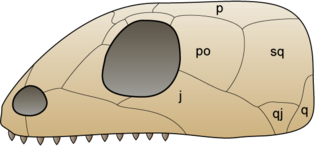
An anapsid is an amniote whose skull lacks one or more skull openings near the temples. Traditionally, the Anapsida are considered the most primitive subclass of amniotes, the ancestral stock from which Synapsida and Diapsida evolved, making anapsids paraphyletic. It is, however, doubtful that all anapsids lack temporal fenestra as a primitive trait, and that all the groups traditionally seen as anapsids truly lacked fenestra.
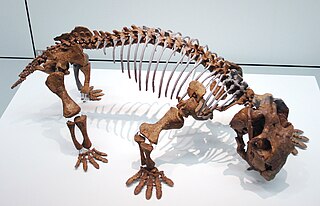
Anomodontia is an extinct group of non-mammalian therapsids from the Permian and Triassic periods. By far the most speciose group are the dicynodonts, a clade of beaked, tusked herbivores. Anomodonts were very diverse during the Middle Permian, including primitive forms like Anomocephalus and Patranomodon and groups like Venyukovioidea and Dromasauria. Dicynodonts became the most successful and abundant of all herbivores in the Late Permian, filling ecological niches ranging from large browsers down to small burrowers. Few dicynodont families survived the Permian–Triassic extinction event, but one lineage (Kannemeyeriiformes) evolved into large, stocky forms that became dominant terrestrial herbivores right until the Late Triassic, when changing conditions caused them to decline, finally going extinct during the Triassic–Jurassic extinction event.
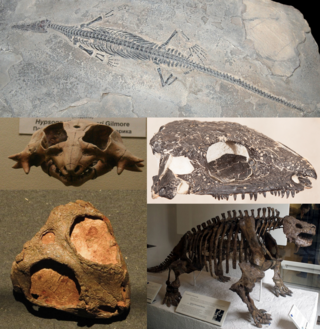
Parareptilia ("near-reptiles") is an extinct subclass or clade of basal sauropsids/reptiles, typically considered the sister taxon to Eureptilia. Parareptiles first arose near the end of the Carboniferous period and achieved their highest diversity during the Permian period. Several ecological innovations were first accomplished by parareptiles among reptiles. These include the first reptiles to return to marine ecosystems (mesosaurs), the first bipedal reptiles, the first reptiles with advanced hearing systems, and the first large herbivorous reptiles. The only parareptiles to survive into the Triassic period were the procolophonoids, a group of small generalists, omnivores, and herbivores. The largest family of procolophonoids, the procolophonids, rediversified in the Triassic, but subsequently declined and became extinct by the end of the period.
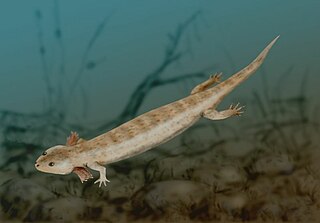
Microsauria is an extinct, possibly polyphyletic order of tetrapods from the late Carboniferous and early Permian periods. It is the most diverse and species-rich group of lepospondyls. Recently, Microsauria has been considered paraphyletic, as several other non-microsaur lepospondyl groups such as Lysorophia seem to be nested in it. Microsauria is now commonly used as a collective term for the grade of lepospondyls that were originally classified as members of Microsauria.
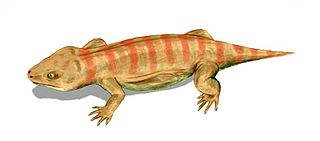
Procolophon is a genus of lizard-like procolophonid parareptiles that first appeared in the Early Triassic (Induan) of South Africa, Brazil, and Antarctica. It persisted through the Permian–Triassic extinction event, but went extinct in the beginning of the Early Middle Triassic. The type species is P. trigoniceps.
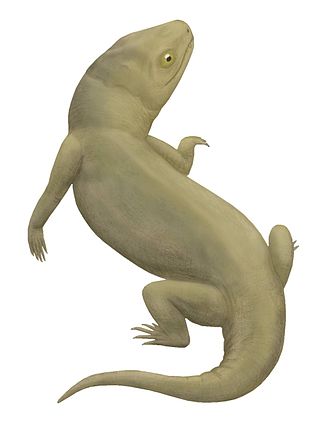
Owenetta is an extinct genus of owenettid procolophonian parareptile. Fossils have been found from the Beaufort Group in the Karoo Basin of South Africa. Although most procolophonians lived during the Triassic, Owenetta existed during the Wuchiapingian and Changhsingian stages of the Late Permian as well as the early Induan stage of the Early Triassic. It is the type genus of the family Owenettidae, and can be distinguished from other related taxa in that the posterior portion of the supratemporal bears a lateral notch and that the pineal foramen is surrounded by a depressed parietal surface on the skull table.
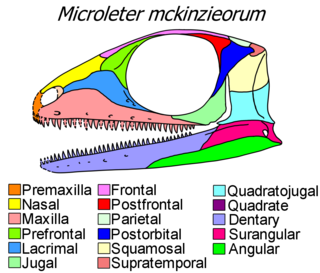
Microleter is an extinct genus of basal procolophonomorph parareptiles which lived in Oklahoma during the Early Permian period. The type and only known species is Microleter mckinzieorum. Microleter is one of several parareptile taxa described from the Richards Spur fissure fills, and can be characterized from its high tooth count, lacrimal/narial contact, short postfrontal, and slit-like temporal emargination edged by the postorbital, jugal, squamosal, and quadratojugal. Contrary to Australothyris, which had a similar phylogenetic position as a basal procolophonomorph, Microleter suggests that early parareptile evolution occurred in Laurasia and that multiple lineages developed openings or emarginations in the temporal region.

Sauropareion is an extinct genus of basal procolophonid parareptile from earliest Triassic deposits of Eastern Cape Province, South Africa. It is known from the holotype SAM PK-11192, skull and partial postcranium. It was collected by the late L. D. Boonstra in 1935 from Barendskraal in the Middelburg District and referred to the Lystrosaurus Assemblage Zone of the Beaufort Group. It was first named by Sean P. Modesto, Hans-Dieter Sues and Ross J. Damiani in 2001 and the type species is Sauropareion anoplus. The generic name means "lizard", sauros, and "cheek", pareion from Greek in reference to the lizard-like appearance of the temporal region. The specific name comes from the Greek word anoplos, meaning "without arms or armour".
Pintosaurus is an extinct genus of basal procolophonid parareptile from Late Triassic deposits of northeastern Uruguay. It is known from the holotype FC-DPV 1181, a partial skull. It was collected from the Buena Vista Formation of the Paraná Basin, in Colonia Orozco, Cerro Largo Department. It was first named by Graciela Piñeiro, Alejandra Rojas and Martín Ubilla in 2004 and the type species is Pintosaurus magnidentis. The generic name honours Dr. Iraja Damiani Pinto. The specific name means "with a large tooth" in Latin, a reference to the large palatal tooth pair.
Theledectes is an extinct genus of theledectine procolophonid parareptile from middle Triassic deposits of Free State Province, South Africa.The type species, Theledectes perforatus, is based on the holotype BP/1/4585, a flattened skull. This skull was collected by the South African palaeontologist, James W. Kitching from Hugoskop in the Rouxville District and referred to subzone B of the Cynognathus Assemblage Zone of the Burgersdorp Formation, Beaufort Group. The genus was first named by Sean P. Modesto and Ross J. Damiani in 2003. However, the species was initially assigned to the genus Thelegnathus by C.E. Gow in 1977, as the species Thelegnathus perforatus.
Phaanthosaurus is an extinct genus of basal procolophonid parareptile from early Triassic deposits of Nizhnii Novgorod, Russian Federation. It is known from the holotype PIN 1025/1, a mandible. It was collected from Vetluga River, Spasskoe village and referred to the Vokhmian terrestrial horizon of the Vokhma Formation. It was first named by P. K. Chudinov and B. P. Vjushkov in 1956 and the type species is Phaanthosaurus ignatjevi.
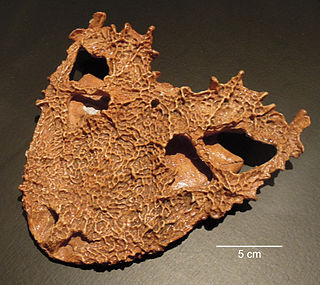
Ankyramorpha is an extinct clade of procolophonomorph parareptiles which lived between the early Cisuralian epoch and the latest Triassic period of Africa, Antarctica, Asia, Australia, Europe, North America and South America.
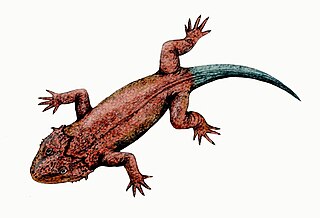
Lanthanosuchoidea is an extinct superfamily of ankyramorph parareptiles from the middle Pennsylvanian to the middle Guadalupian epoch of Europe, North America and Asia. It was named by the Russian paleontologist Ivachnenko in 1980, and it contains two families Acleistorhinidae and Lanthanosuchidae.

Eumetabolodon is an extinct genus of procolophonine procolophonid parareptile from early and middle Triassic deposits of Nei Mongol, northern China. Two species of Eumetabolodon were named by J. L. Li in 1983 and the type species is Eumetabolodon bathycephalus.
Anomoiodon is an extinct genus of procolophonine procolophonid parareptile from early Triassic deposits of Thuringia, Germany. It is known only from the holotype MB.R.3539B and paratype MB.R.3539A, two articulated, three-dimensionally preserved partial skeletons on one block which represent two individuals. The holotype includes nearly complete skull and lower jaw. The block was collected from the lowest layer of the Chirotherium Sandstone Member of the Solling Formation, dating to the early Olenekian faunal stage of the Early Triassic, about 249-247 million years ago. It was first named by Friedrich von Huene in 1939 and the type species is Anomoiodon liliensterni. Laura K. Säilä, who redescribed Anomoiodon in 2008, found it to be a leptopleuronine using a phylogenetic analysis. The most recent analysis, performed by Ruta et al. (2011) found it to be a procolophonine instead. However, both analyses found that it is most closely related to the Russian procolophonid Kapes.

Procolophoninae is an extinct subfamily of procolophonid parareptiles from the late Early Triassic to the early Middle Triassic of Africa, Antarctica, Asia, Europe and South America. Currently, the oldest-known procolophonine is Procolophon from the earliest Olenekian stage.
Leptopleuroninae is an extinct subfamily of procolophonid reptiles. It is defined as all taxa closer to Leptopleuron lacertinum than to Procolophon trigoniceps. The oldest member of Leptopleuroninae is Phonodus dutoitorum from the Induan age of the Early Triassic. It is the only procolophonid group that survived into the Late Triassic.
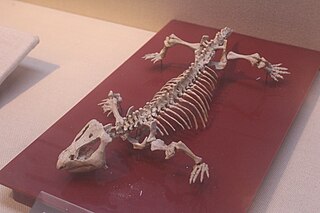
Pentaedrusaurus is an extinct genus of procolophonid parareptile from the Early Triassic of China. It is one of the most basal members of the procolophonid subfamily Leptopleuroninae. The only known species of Pentaedrusaurus, P. ordosianus, was named in 1989 from the Heshanggou Formation.
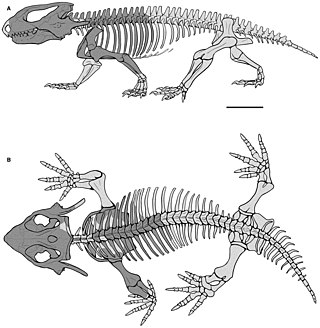
Kapes is an extinct genus of procolophonid parareptile from the Lower and Middle Triassic of the United Kingdom and Russia. The type species K. amaenus was named in 1975 from the banks of the Vychegda River in the Komi Republic of Russia. In 1983, a new species was brought into the genus, K. majmesculae. K. majmesculae was first named in 1968 as a member of the genus Tichvinskia. A third Russian species, K. serotinus, was named in 1991. In 2002, Kapes bentoni was described from the Middle Triassic Otter Sandstone Formation of Devon, England, extending the geographic range of Kapes. In the same paper, K. serotinus was synonymized with K. majmesculae and another Russian species was assigned to Kapes called K. komiensis. K. komiensis was first named in 1975 as a member of the genus Macrophon.
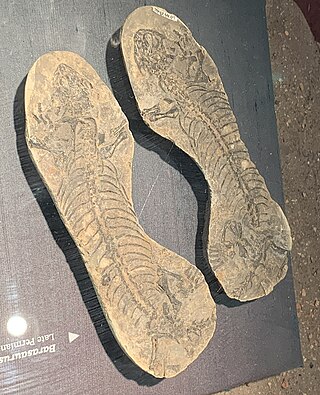
Barasaurus is an extinct genus of owenettid procolophonoid parareptile known from the Late Permian and Early Triassic of Madagascar. It contains a single species, Barasaurus besairiei.


















